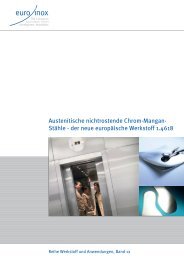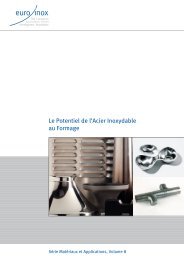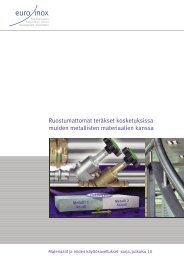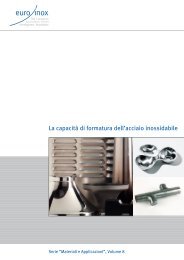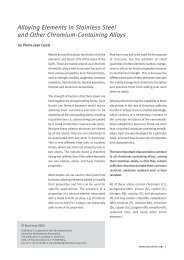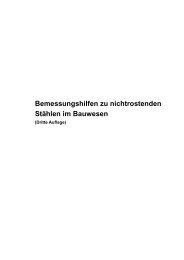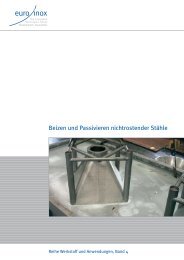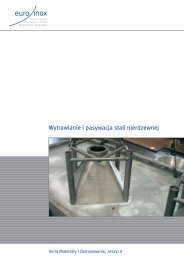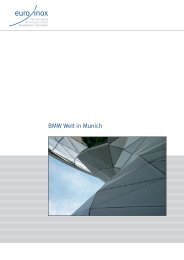Stainless Steel - The Safe Choice - Euro Inox
Stainless Steel - The Safe Choice - Euro Inox
Stainless Steel - The Safe Choice - Euro Inox
Create successful ePaper yourself
Turn your PDF publications into a flip-book with our unique Google optimized e-Paper software.
Editorial<br />
<strong>Stainless</strong> <strong>Steel</strong> – <strong>The</strong> <strong>Safe</strong> <strong>Choice</strong><br />
Environment and Human Health Series – Volume 1<br />
First edition, May 2000<br />
<strong>Euro</strong> <strong>Inox</strong>, Brussels<br />
Editor<br />
Headquarters<br />
<strong>Euro</strong> <strong>Inox</strong> – 241 route d’Arlon<br />
1150 Luxemburg, Grand Duchy of Luxemburg<br />
Phone +352 261 03 050<br />
Fax +352 261 03 051<br />
Executive office:<br />
Diamant Building, Bd. A. Reyers 80,<br />
1030 Brussels, Belgium<br />
Phone +32 2 706 82 67<br />
Fax +32 2 706 82 69<br />
E-mail: info@euro-inox.org<br />
Internet: www.euro-inox.org<br />
Author<br />
Pierre-Jean Cunat, Brussels<br />
Derived from the presentation made at the International<br />
Congress - <strong>Stainless</strong> <strong>Steel</strong> '99 - Science and Market -<br />
Chia Laguna (Italy) - 6/9 June 1999 - Proceedings Vol. 1,<br />
191-200<br />
Content<br />
1 Introduction 2<br />
2 What are stainless steels? 2<br />
3 What is harmful to health ? 2<br />
4 <strong>The</strong> essential character of metals 3<br />
4.1 <strong>The</strong> essential character of chromium 3<br />
4.2 <strong>The</strong> essential character of nickel 4<br />
5 Hazard or risk ? 4<br />
5.1 <strong>Stainless</strong> steels in contact with skin 5<br />
5.2 <strong>Stainless</strong> steels in contact with food 7<br />
5.3 <strong>Stainless</strong> steels<br />
in contact with drinking water 8<br />
6 Conclusion 9<br />
References 10<br />
<strong>Euro</strong> <strong>Inox</strong> has made every effort to ensure that the<br />
information presented here is technically correct. However,<br />
the reader is advised that the material contained herein<br />
is for general information purposes only. <strong>Euro</strong> <strong>Inox</strong>, its<br />
members, staff, and consultants, specifically disclaim<br />
any liability or responsibility for loss, damage, or injury,<br />
resulting from the use of the information contained in<br />
this publication.<br />
Acknowledgements:<br />
Title photos: Christian Carleer<br />
© <strong>Euro</strong> <strong>Inox</strong> 2002 www.euro-inox.org · 1
SAFE STAINLESS STEEL<br />
1. Introduction<br />
<strong>The</strong> aim of this paper is to show that stainless<br />
steels which have been used in a wide range<br />
of applications such as cooking utensils,<br />
sinks, food and drink industry equipment,<br />
hospital and medical equipment, prothetic<br />
human implants, etc... are safe for human<br />
health.<br />
2. What are <strong>Stainless</strong> <strong>Steel</strong>s ?<br />
<strong>Stainless</strong> steels are defined as iron based alloys<br />
containing at least 10.5 % chromium and<br />
a maximum of 1.2 % carbon.<br />
One of the most important properties of stainless<br />
steels is their resistance to corrosion.<br />
Corrosion resistance in stainless steels is provided<br />
by a passive surface film which acts as<br />
a barrier between the alloy and the surrounding<br />
medium. <strong>The</strong> passive film is a continuous,<br />
non-porous and insoluble film which,<br />
if broken, is self-healing under normal conditions.<br />
Chromium plays an essential role in the formation<br />
and the stabilisation of the passive<br />
film. Other elements can influence the effectiveness<br />
of chromium in forming or maintaining<br />
the film, but no other element can, by<br />
itself, create the properties of stainless steels.<br />
Increasing the chromium content from 10.5 %<br />
to the 18 % level typical of the austenitic<br />
stainless steels, provides increased stability<br />
of the passive film. In austenitic stainless<br />
steels, the nickel content does not contribute<br />
directly to the composition of the passive<br />
film, but does promote repassivation, especially<br />
in reducing atmospheres.<br />
Molybdenum in combination with chromium<br />
is very effective in stabilising the passive film<br />
in the presence of chlorides. It also considerably<br />
improves the resistance to pitting and<br />
crevice corrosion in neutral chloride solutions.<br />
3. What is harmful to health ?<br />
Everything taken in by the body or affecting<br />
it in excess can have a negative influence,<br />
whether it be the level of nutrition, special<br />
foodstuffs, drugs, metallic trace elements or<br />
even vitamins.<br />
<strong>The</strong> reasonings of Paracelsus (1493 - 1541)<br />
are valid still today :<br />
“What is not poisonous ?<br />
Everything is poisonous.<br />
Only the dose makes a thing not<br />
poisonous.”<br />
Following this definition no material could be<br />
regarded as toxic “a priori”. One has also to<br />
notice that the toxicological behaviour of metallic<br />
alloys depends strongly on the valence<br />
state of the metal.<br />
© <strong>Euro</strong> <strong>Inox</strong> 2002 www.euro-inox.org · 2
4. <strong>The</strong> essential character<br />
of metals<br />
Metals are naturally occurring components<br />
of the environment albeit often in small quantities.<br />
Most of them are required for plant,<br />
animal and human health and development.<br />
For many of them the dose-response relationship<br />
in figure 1 illustrates the concept of<br />
deficiency-sufficiency-toxicity.<br />
Various metal compounds or trace nutrients<br />
have been recognised to be essential. <strong>The</strong><br />
main criteria used for establishing the<br />
essential character of metals and metal compounds<br />
are :<br />
a) <strong>The</strong> metal or the metal compound must<br />
be present in the soil and water environment<br />
b) <strong>The</strong> metal or the metal compound must<br />
be present in the normal diet<br />
c) <strong>The</strong> metal or the metal compound must<br />
be present in body tissues and biological<br />
fluids<br />
d) A biological activity or metabolic activity<br />
must be associated with the metal.<br />
4.1 <strong>The</strong> essential character of Chromium<br />
Chromium is the 24th element on the periodic<br />
chart, situated between vanadium and manganese,<br />
and has an atomic weight of 52. Chromium<br />
is the 13th most abundant element in<br />
the Earth’s crust at about 400 ppm.<br />
100<br />
RISK OF DEFICIENCY<br />
Deficiency Sufficiency Toxicity<br />
Chromium may occur in several<br />
valent states :<br />
• Metallic form<br />
(valent state 0)<br />
• Trivalent form (Cr III) and<br />
• Hexavalent form (Cr VI).<br />
TOTAL ORAL EXPOSURE OR INTAKE<br />
Trivalent chromium (Cr III) occurs naturally in<br />
the environment. It is an essential nutrient<br />
required by the human body to promote the<br />
action of insulin in body tissues so that glucose,<br />
protein and fat can be used (1,2,3).<br />
Cases of chromium deficiency resulting in<br />
impaired glucose tolerance have been<br />
reported, which have been corrected by an<br />
addition of chromium to the daily diet. As<br />
Trivalent chromium (Cr III) is an essential<br />
nutrient, a daily intake of 50 to 500 µg of<br />
Cr III is recommended for adults.<br />
Even if present in very large amounts, trivalent<br />
chromium (Cr III) has very little toxic effect.<br />
Chromium as a pure metal has no adverse<br />
effect.<br />
SAFE STAINLESS STEEL<br />
Figure 1 : Typical dose - response curve for an essential trace element<br />
© <strong>Euro</strong> <strong>Inox</strong> 2002 www.euro-inox.org · 3<br />
100<br />
RISK OF TOXICITY
SAFE STAINLESS STEEL<br />
Both acute and chronic toxicity from chromium<br />
are mainly caused by hexavalent chromium<br />
compounds (Cr VI). If taken orally,<br />
soluble hexavalent chromium would be reduced<br />
to the desirable trivalent chromium<br />
before being absorbed in the small intestine.<br />
In the case of stainless steel utensils or food<br />
process equipment, any chromium released<br />
from the cooking processes will be in the trivalent<br />
state and no toxicity is to be expected.<br />
Not only it is non toxic but it can be<br />
beneficial to health.<br />
4.2 <strong>The</strong> essential character of Nickel<br />
Nickel is the 28th element on the periodic chart<br />
and is situated between cobalt and copper.<br />
It is a metallic element belonging to the group<br />
of “transition metals” (Group VIII) like iron<br />
and cobalt, and has an atomic weight of 59.<br />
Nickel is the 24th most abundant element in<br />
the Earth’s crust at about 80 ppm.<br />
<strong>The</strong> need for nickel in the diet of animals has<br />
been proven (4,5) but the ubiquitous nature<br />
of nickel makes it difficult to establish its<br />
need in the human diet. However, a nickel<br />
dietary requirement for humans of 50 µg/kg<br />
of diet has been proposed by Nielsen (6).<br />
It is impossible to be skin-sensitised to nickel<br />
by the ingestion of nickel compounds, but<br />
some investigators have shown that ingested<br />
nickel may cause exacerbation of hand eczema<br />
in those people who are already sensitised<br />
to nickel. Although only a minority of<br />
people react to oral nickel doses below 1250 µg<br />
(7), it has been concluded that a reduction of<br />
the dietary intake of nickel may be beneficial<br />
for some already nickel sensitised people (8).<br />
In contrast, it has been found that oral exposure<br />
to nickel prior to sensitisation results in<br />
a reduced frequency of nickel hypersensitivity.<br />
That conclusion was reached from a survey<br />
(9) of persons who had oral contact with<br />
nickel at an early age prior to ear piercing, a<br />
common cause of nickel sensitisation. <strong>The</strong><br />
effectiveness of nickel ingestion as a way of<br />
promoting tolerance to sensitisation by nickel<br />
was subsequently demonstrated (10).<br />
5. Hazard or risk?<br />
It is worth defining these items. <strong>The</strong> hazard of<br />
a metal or a metallic alloy is its “potential” to<br />
cause harm and it is one way of expressing the<br />
(adverse) “intrinsic properties” of a metal or<br />
a metallic alloy. Hazard identification for a<br />
metallic alloy, (i.e. the determination of adverse<br />
effects which an alloy has a potential<br />
capacity to cause) must be based on the physical,<br />
chemical and toxicological properties of<br />
the alloy. Consequently, hazard identification<br />
should take into account the physical<br />
forms of an alloy (massive form or powdered<br />
form) and its chemical properties paying particular<br />
attention to its corrosion resistance in<br />
a different set of media.<br />
<strong>The</strong> risk posed by a metallic alloy is a probability<br />
function and is the likelihood of harm occurring.<br />
It depends on the exposure to the<br />
(hazardous) metallic alloy. For simplicity :<br />
Risk = Hazard x Exposure<br />
© <strong>Euro</strong> <strong>Inox</strong> 2002 www.euro-inox.org · 4
Consequently, most metallic alloys in the<br />
“massive” form (which represents more than<br />
99 % of total metallic alloy production in the<br />
world) are considered to present no risk to<br />
human health.<br />
5.1 <strong>Stainless</strong> steel in contact with skin<br />
Although Nickel release from nickel-plated<br />
materials may induce allergic contact dermatitis,<br />
for nickel-containing stainless steels<br />
(i.e. austenitic stainless steels) the effect is<br />
much different.<br />
<strong>The</strong> aim of recent studies (11,12,13) was to<br />
define the risk of nickel contact dermatitis<br />
from AISI 304 (1.4301), AISI 316L (1.4404)<br />
and AISI 430 (1.4016) grades as well as a<br />
high sulphur containing stainless steel grade<br />
AISI 303 (1.4305) and a nickel-plated steel.<br />
Methods included nickel release in synthetic<br />
sweat, electrochemical investigations, and<br />
clinical patch tests on already sensitised persons.<br />
Table 1. gives the chemical composition<br />
of the different materials used in the<br />
studies. <strong>The</strong>se grades will be identified using<br />
the AISI and the <strong>Euro</strong>pean standards.<br />
Leaching experiments were performed mainly<br />
in artificial sweat solutions at pH 4.5 at room<br />
temperature for one week. Composition of<br />
the artificial sweat solution was as follows :<br />
0.3 % NaCl, 0.1 % Na2SO4, 0.2 % urea and 0.2<br />
% lactic acid. <strong>The</strong> stainless steels were also<br />
tested according to the standardised test (pr<br />
EN 1811). <strong>The</strong> method described therein was<br />
developed for implementation of the 12th amendment (Directive 94/27/EC) to Directive<br />
76/769/EEC relating the restrictions of the<br />
marketing and use of certain dangerous substances<br />
and preparations. <strong>The</strong> composition of<br />
the artificial sweat solution was as follows :<br />
0.5 % NaCl, 0.1 % urea, 0.1 % lactic acid,<br />
and NH3 to adjust the pH at 6.6.<br />
Electrochemical investigations were carried<br />
out to compare the stability (passivity/activity)<br />
of materials in different solutions. Corrosion<br />
(activity) and corrosion resistance<br />
(passivity) of metals and metallic alloys are basically<br />
electrochemical processes. Electrochemical<br />
tests were conducted in synthetic<br />
sweat solutions at pH 4.5 and 6.6. Samples<br />
were tested in the as received conditions or<br />
wet-polished.<br />
Clinical patch tests were performed on 50 already<br />
Ni-sensitised persons, with circular<br />
samples of the four stainless steel grades<br />
and of the Ni-plated steel in the as received<br />
conditions. <strong>The</strong> patch tests were removed after<br />
2 days of exposure, and readings were<br />
carried out 30 min after.<br />
<strong>The</strong> results of leaching experiments in the<br />
synthetic sweat-solutions show three groups<br />
of materials characterised by three different<br />
levels of nickel migration:<br />
SAFE STAINLESS STEEL<br />
Grade AISI 303 AISI 304 AISI 316L AISI 430 Nickel<br />
1.4305 1.4301 1.4404 1.4016<br />
C 0.064 0.036 0.021 0.037<br />
Si 0.54 0.49 0.61 0.33 0.01<br />
Mn 1.79 0.81 1.67 0.43<br />
Ni 8.45 8.65 11.29 0.11 99.8<br />
Cr 17.25 18.18 17.87 16.59<br />
Mo 0.26 0.26 2.15 0.11<br />
S 0.2753 0.0069 0.0018 0.0010 0.0020<br />
Table 1: Chemical composition<br />
(wg %) of the<br />
stainless steel grades<br />
and nickel used in the<br />
Ni allergy study<br />
© <strong>Euro</strong> <strong>Inox</strong> 2002 www.euro-inox.org · 5
SAFE STAINLESS STEEL<br />
1. A very low nickel release (less than 0.05<br />
µg/cm2 /week at pH 4.5 and 6.6 ) close to<br />
the detection limit and which must be considered<br />
as harmless according to the <strong>Euro</strong>pean<br />
Directive 94/27/EC. This group<br />
includes the three low-sulphur stainless<br />
steel grades (AISI 430, 304 and 316L).<br />
2. An intermediate nickel release, close to<br />
the 0.5 µg/cm2 /week value which is considered<br />
as the limit for a positive reaction<br />
in already Ni-sensitised persons, following<br />
a prolonged contact with skin. This was for<br />
the resulphurised grade (AISI 303).<br />
Grade<br />
AISI 304/1.4301<br />
Domain of<br />
passivity<br />
Current density Grouping<br />
AISI 316L/1.4404 Yes < 1µA/cm2 1<br />
AISI 303/1.4305 No > 1mA/cm2 2<br />
Ni-plated steel No >> 1mA/cm2 3<br />
Table 2: Electrochemical<br />
behaviour in a synthetic<br />
sweat solution of pH 4.5<br />
at 23°C<br />
3. A high release (75 µg/cm2 /week) which<br />
probably will be harmful in case of prolonged<br />
contact of the material with skin.<br />
<strong>The</strong> Ni-plated steel belongs to that group.<br />
<strong>The</strong> results of leaching experiments correlate<br />
with those from the electrochemical (polarisation)<br />
tests which show that in synthetic<br />
sweat solutions:<br />
1. <strong>The</strong> low-sulphur stainless steel AISI 304<br />
and 316L grades (i.e. standard austenitic<br />
grades) have excellent corrosion resistance,<br />
characterised by the presence of<br />
a passive domain.<br />
2. By comparison the resulphurised stainless<br />
steel (AISI 303) and Ni-plated steel<br />
have poor corrosion resistance. <strong>The</strong>y present<br />
no passive domain in this medium<br />
of synthetic sweat.<br />
From these experiments it can be concluded<br />
that there is no corrosion and correspondingly<br />
negligible cation migration for AISI 304 and<br />
316L grades. In comparison for AISI 303 grade<br />
and even more for the Ni-plated steel the current<br />
density is high (more than 1 mA/cm2 ) indicating<br />
an active state and consequently<br />
cation migration. <strong>The</strong> result of electrochemical<br />
investigations are summa-rised in Table 2.<br />
Results of clinical patch tests clearly show<br />
that standard austenitic stainless steel (AISI<br />
304/1.4301 and 316L/1.4404) and the ferritic<br />
grade (AISI 430/1.4016 : Ni-free 17 %<br />
Cr) stainless steel are harmless since no allergic<br />
reaction was seen on the 50 already Nisensitised<br />
persons. In contrast, the resulfurised<br />
austenitic stainless steel (AISI<br />
303/1.4305) induces allergic reaction for a<br />
few persons (14 %) and the Ni-plated steel for<br />
nearly all the persons (96 %).<br />
<strong>The</strong> correlation between leaching experiments,<br />
electrochemical investigations and<br />
clinical patch test validate the value of 0.5<br />
µg/cm2 /week as a limit of nickel release in<br />
a synthetic sweat solution. Table 3 summarises<br />
the situation.<br />
© <strong>Euro</strong> <strong>Inox</strong> 2002 www.euro-inox.org · 6
Grade Corrosion resistance Ni release in Clinical test Grouping<br />
(passivity) synthetic (allergic<br />
sweat reactions)<br />
AISI 430/1.4016<br />
AISI 304/1.4301<br />
(µg/cm2/week) (%)<br />
AISI 316L/1.4404 Yes < 0.05 0 1<br />
AISI 303/1.4305 Weak ≈ 0.5 14 2<br />
Ni-plated steel No > 70 96 3<br />
5.2 <strong>Stainless</strong> steels in contact with food<br />
<strong>Stainless</strong> steel plays a vital role in the production<br />
and processing of food and beverages.<br />
For over 70 years stainless steel has<br />
been used in the preparation, processing and<br />
transport of food products to ensure a high<br />
standard of quality. It does not affect the<br />
taste of food and drink. <strong>Stainless</strong> steel has a<br />
high resistance to cleaning agents, disinfectants<br />
and sterilising agents such as pressurised<br />
steam.<br />
Chromium and nickel release from stainless<br />
steel in contact with food or during its processing,<br />
storage and during meal preparation<br />
and cooking is, in most cases, negligible.<br />
Experiments on pick-up of chromium and<br />
nickel from stainless steel utensils have been<br />
conducted using acid fruit (14). Experiments<br />
using AISI 430Ti/1.4510 and AISI 444/1.4521<br />
(ferritic grades) and AISI 304/1.4301 (austenitic<br />
grade) in a boiling acetic acid solution<br />
showed that chromium and nickel release is<br />
very low. <strong>The</strong> concentration observed were<br />
close to the detection limits i.e. 30 µg/l for<br />
chromium and 10 µg/l for nickel.<br />
A recent field investigation (15) of actual<br />
operation using meals cooked in glass,<br />
ferritic (AISI 436/1.4526) and austenitic<br />
(AISI 304/1.4301) stainless steel pans<br />
showed that the levels of nickel and chromium<br />
fall either within or very close to the<br />
range of chromium and nickel reported in the<br />
literature.<br />
Statistical tests showed that nickel and chromium<br />
intake from meals cooked in stainless<br />
steel utensils (in austenitic 18.2 % Cr - 8.6 %<br />
Ni/304 grade and in ferritic 16.6 % Cr - 1.0 %<br />
Mo niobium stabilised/436 grade) was insignificant.<br />
It is clear that the use of stainless steel<br />
cooking utensils does not provide a significant<br />
source of dietary chromium or<br />
nickel and there is no advantage to be<br />
gained by nickel-sensitive persons who<br />
suffer from contact allergy by avoiding<br />
the use of stainless steel utensils.<br />
SAFE STAINLESS STEEL<br />
Table 3: <strong>Stainless</strong> steel<br />
in prolonged contact<br />
with skin and the Ni<br />
contact dermatitis issue.<br />
© <strong>Euro</strong> <strong>Inox</strong> 2002 www.euro-inox.org · 7
SAFE STAINLESS STEEL<br />
5.3 <strong>Stainless</strong> steel in contact<br />
with drinking water<br />
Several surveys of performance of stainless<br />
steel in drinking water systems were carried<br />
out from 1997 to 1999. Three types of stainless<br />
steel were used for the pipework simulation<br />
(17) in a cold water system, i.e. stainless<br />
steel X5CrNi18-10/1.4301 containing 18 %<br />
chromium and 10 % nickel, X5CrNiMo17-12-<br />
2/1.4401 containing 17 % chromium, 12 %<br />
nickel and 2 % molybdenum and X2CrMoTi<br />
18-2/1.4521 containing 18 % chromium and<br />
2 % molybdenum.<br />
Electrochemical investigations (18, 19) were<br />
also carried out to compare the stability of<br />
alloys in de-aerated synthetic water at pH 6.6<br />
and at ambient temperature (23°C). <strong>The</strong> composition<br />
of the synthetic water solution was<br />
as follows : Cl- = 200 mg/l, SO 2-<br />
4 = 250 mg/l,<br />
Mg3+ = 50 mg/l, Na + = 150mg/l and K + =<br />
12 mg/l.<br />
<strong>The</strong> results of the electrochemical tests show<br />
the presence of a large passive domain in<br />
which the current density is less than 0.5<br />
µA/cm2 , which implies no corrosion having<br />
taken place.<br />
<strong>The</strong> pipework system (rig system) was designed<br />
to investigate leaching over a period<br />
of several months. Leaching data were obtained<br />
for chromium, molybdenum, iron, titanium,<br />
and the results were as follows:<br />
• Chromium species were detected in the<br />
solution as trivalent chromium (Cr3+ ).<br />
<strong>The</strong> values range from detection limit of<br />
1 µg/l to 2 µg/l. As trivalent chromium was<br />
one of the components of the passive layer,<br />
these values clearly show that the alloys<br />
were in the passive state, implying that no<br />
corrosion occured.<br />
• Molybdenum concentrations were less than<br />
1 µg/l. Molybdenum enhances the properties<br />
of the passive layer and makes all<br />
stainless steels more corrosion resistant,<br />
particularly to pitting in chloride environments.<br />
Pitting corrosion resistance can be<br />
expressed as pitting resistance equivalent<br />
number (PRE), taking into account the role<br />
of chromium and molybdenum, according<br />
to the emperical relationship to predict the<br />
pitting resistance of :<br />
· Ferritic stainless steels :<br />
PRE = % Cr + 3.3 (% Mo)<br />
· Austenitic and duplex stainless steels :<br />
PRE = % Cr + 3.3 (%Mo) + X (%N)<br />
with X = 16 for duplex stainless steels<br />
and X = 30 for austenitic stainless<br />
steels<br />
• Iron, as Fe3+ , is, with chromium, a major<br />
constituent element of the passive film. It<br />
was leached in small quantities (less than<br />
50 µg/l) but release decreased with time.<br />
<strong>The</strong> explanation for the result is that the<br />
passive film is mainly composed of Fe and<br />
Cr oxides and hydroxides and that the Fe<br />
components are less stable than the Cr<br />
components. Thus they are dissolved preferentially.<br />
This leads to a Cr-enrichment<br />
of the passive film and a corresponding<br />
increased corrosion resistance of the material.<br />
© <strong>Euro</strong> <strong>Inox</strong> 2002 www.euro-inox.org · 8
• Titanium is added to the ferritic grade X2Cr-<br />
MoTi18-2 to prevent intergranular corrosion<br />
which may occur in welded zones. Its<br />
concentration was always less than 5 µg/l.<br />
It improves the pitting corrosion resistance<br />
of this material.<br />
• Nickel concentrations were, in most cases,<br />
less than 2 µg/l. In this context, it should<br />
be noticed that Ni-release was very low<br />
and this result confirms the absence of this<br />
element in the passive film.<br />
Following these results, it can be concluded<br />
that the three stainless steel grades<br />
· X5CrNi18-10/1.4301<br />
(Fe-Cr-Ni austenitic alloy)<br />
· X5CrNi17-12-2/1.4401<br />
(Fe-Cr-Ni-Mo austenitic alloy)<br />
· X2CrTi18-2/1.4521<br />
(Fe-Cr-Mo ferritic alloy)<br />
comply with <strong>Euro</strong>pean regulations on the quality<br />
of water intended for human consumption<br />
(Council Directive 98/83/EC). <strong>The</strong><br />
parametric values reported in the above directive<br />
are :<br />
· 50 µg/l for chromium<br />
· 200 µg/l for iron<br />
· 20 µg/l for nickel<br />
6. Conclusions<br />
<strong>The</strong> wide range of stainless steel applications<br />
brings a large number of consumers into<br />
stainless steel contact be exposed (skin<br />
contact, ingestion of metal ions).<br />
Nickel release from the widely used austenitic<br />
stainless steels (X5CrNi18-10/1.4301 and<br />
X5CrNi17-12-2/1.4401) in prolonged contact<br />
with skin is negligible and no allergic reaction<br />
was seen in already Ni-sensitised persons,<br />
while the lesser used high sulphur grade<br />
(X8CrNiS18-9/1.4305) could elicit reactions.<br />
Release of chromium and nickel from stainless<br />
steel utensils is, in most cases, negligible. It<br />
is clear that the use of stainless steel cooking<br />
utensils does not provide a source of<br />
dietary chromium or nickel of any significance.<br />
<strong>The</strong>re is no advantage to be gained by Ni-sensitised<br />
persons suffering from contact allergy,<br />
in avoiding the use of stainless steel utensils.<br />
As a result of research carried out by international<br />
authorities it is clear that stainless<br />
steel in a material complying with the <strong>Euro</strong>pean<br />
regulations dealing with drinking water.<br />
SAFE STAINLESS STEEL<br />
© <strong>Euro</strong> <strong>Inox</strong> 2002 www.euro-inox.org · 9
SAFE STAINLESS STEEL<br />
7. References<br />
1) Anderson RA. Chromium and parenteral<br />
nutrition 1995; 11, 83-86<br />
2) O’Flaherty EJ. Chromium as an essential<br />
and toxic metal. Scand J. Work Environ<br />
Health 1993; 19, 124-125<br />
3) Anderson RA. Chromium, glucose tolerance<br />
and diabetes. Biol Trace Elem<br />
Res 1992, 32, 19-24<br />
4) Nielsen FH, Myron DM, Givand SH,<br />
Zimmerman TJ, and Ollerich DA. Nickel<br />
deficiency in rats. Journal of Nutrition<br />
1975; 105, 1620-1630<br />
5) Anke M, Grun M, and Kronemann H.<br />
Distribution in nickel deficient goats<br />
and their offspring. Nickel toxicology,<br />
edited by SS. Brown and FW Sunderman<br />
(London : Academic Press) 1980,<br />
69-72<br />
6) Nielsen FH. Possible future implications<br />
of nickel, arsenic, silicon, vanadium<br />
and other ultratrace elements in<br />
human nutrition. Clinical, Biochemical<br />
and Nutritional Aspects of Trace Elements<br />
(New York : Alan R. Liss Inc)<br />
1982, 379-404<br />
7) Menne T and Maibach HI. Systemic<br />
contact-type dermatitis. Dermatotoxicology,<br />
4th Edition, edited by FN Mazulli<br />
and HI Maibach (New York :<br />
Hemisphere Publishing Corp) 1991,<br />
453-472<br />
8) Veien NK, Hattel T, and Lauerberg G.<br />
Low nickel diet : an open prospective<br />
trial. Journal of the American Academy<br />
of Dermatology, 1993; 29 (6), 1002-<br />
1007<br />
9) Van Hoogstraten IMW, Andersen KE,<br />
von Blomberg BM, Boden D, Bruynzeel<br />
DP, Burrows D, Camarasa JG et al. Reduced<br />
frequency of nickel allergy upon<br />
oral nickel contact at an early age. Clinical<br />
and Experimental Immunology<br />
1991; 85, 441-445<br />
10) Van Hoogstraten IMW, Boss C, von<br />
Blomberg ME, Scheper RJ, and Kraal<br />
G. Oral induction of tolerance to nickel<br />
sensitisation in mice. Journal of Investigative<br />
Dermatology 1993; 101 (1),<br />
26-31<br />
11) Haudrechy P, Foussereau J, Mantout B,<br />
and Baroux B. Nickel release from 304<br />
and 316 stainless steels in synthetic<br />
sweat. Comparison with nickel and<br />
nickel plated metals. Consequences<br />
on allergic contact dermatitis. Corrosion<br />
Science 1993; 35 (1-4), 329-336<br />
© <strong>Euro</strong> <strong>Inox</strong> 2002 www.euro-inox.org · 10
12) Haudrechy P, Foussereau J, Mantout B<br />
and Baroux B. Nickel release from<br />
nickel-plated metals and stainless<br />
steels. Contact Dermatitis 1994; 31,<br />
249-255<br />
13) Haudrechy P, Mantout B, Frappaz A,<br />
Rousseau D, Chabeau G, Faure M, and<br />
Claudy A. Nickel release from stainless<br />
steels. Contact Dermatitis 1997; 37,<br />
113-117<br />
14) Flint GN and Packirisamy S. Purity of<br />
food cooked in stainless steel utensils.<br />
Food Additives and Contaminants<br />
1997; 14 (2), 115-126<br />
15) Accominotti M, Bost M, Haudrechy P,<br />
Mantout B, Cunat PJ, Comet F, Mouterde<br />
C, Plantard F, Chambon P, and<br />
Vallon JJ. Contribution to chromium<br />
and nickel enrichment during cooking<br />
of foods in stainless steel utensils.<br />
Contact Dermatitis 1998; 38, 305-310<br />
16) Büning-Pfaue H, Strompen C. Bestimmung<br />
der Gebrauchssicherheit von<br />
Edelstahl-Kochtöpfen – Nickelfreisetzung<br />
aus Kochtöpfen aus nichtrostendem<br />
Stahl. Institute for Food Science<br />
and Food Chemistry of the University<br />
of Bonn, 1999<br />
17) Co-normative research on test methods<br />
for materials in contact with<br />
drinking water, CRECEP Report, July<br />
1999<br />
18) Baroux B and Baltenneck S, Critère de<br />
choix des aciers inoxydables pour emploi<br />
au contact des eaux chlorurées,<br />
de l’eau de ville à l’eau de mer,<br />
journées des aciers spéciaux et des<br />
eaux industrielles, XIIième Conférence<br />
Internationale des Arts Chimiques, Paris,<br />
12 décembre 1980<br />
19) Haudrechy P, Private Communication,<br />
Ugine, 1993<br />
SAFE STAINLESS STEEL<br />
© <strong>Euro</strong> <strong>Inox</strong> 2002 www.euro-inox.org · 11




